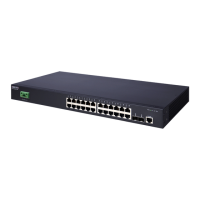C
HAPTER
4
| System Settings
Setting an IP Address
– 42 –
interface identifier (i.e., the physical MAC address). You can manually
configure a link-local address by entering the full address with the
network prefix FE80.
◆ To connect to a larger network with multiple subnets, you must
configure a global unicast address. There are several alternatives to
configuring this address type:
■
The global unicast address can be automatically configured by
taking the network prefix from router advertisements observed on
the local interface, and using the modified EUI-64 form of the
interface identifier to automatically create the host portion of the
address. This option can be selected by enabling the Auto
Configuration option.
■
You can also manually configure the global unicast address by
entering the full address and prefix length.
PARAMETERS
The following parameters are displayed on the IPv6 Address Setting page:
◆ Auto Configuration – Enables stateless autoconfiguration of IPv6
addresses on an interface and enables IPv6 functionality on the
interface. The network portion of the address is based on prefixes
received in IPv6 router advertisement messages, and the host portion
is automatically generated using the modified EUI-64 form of the
interface identifier; i.e., the switch's MAC address. (Default: Disabled)
◆ IPv6 Address – Manually configures a global unicast address by
specifying the full address and network prefix length (in the Prefix
field). (Default: null)
◆ Prefix Length – Defines the prefix length as a decimal value indicating
how many contiguous bits (starting at the left) of the address comprise
the prefix; that is, the network portion of the address. (Default: 0)
◆ Router – Sets the IPv6 address of the default next hop router.
An IPv6 default gateway must be defined if the management station is
located in a different IPv6 segment.
An IPv6 default gateway can only be successfully set when a network
interface that directly connects to the gateway has been configured on
the switch.

